
“To live by love is to banish all fear.”
Thérèse wrote these words more than a century ago. Time does not alter their strength.
Saint Thérèse of Lisieux, first Thérèse Martin, then Sister Thérèse of the Child Jesus and the Holy Face, was a woman who was both fragile and strong-willed. The fascination, love, and interest she aroused are not the result of extraordinary feats. Her life was short and simple.
The universality of her message lies in her humanity. The events that marked Thérèse’s life take on their meaning and importance from the way in which they were lived, and they were lived with the power of the heart and the demands of a great soul. Thérèse Martin chose to trust in God, to let herself be overwhelmed by love, and to live it out the smallest everyday actions.
This is her story…
Based on the idea of a retired pilot suggested to Mother Agnès de Jésus (Pauline, sister of Thérèse) at the end of the 1930s and established on the site of the Basilica in 2006, this small wax museum allows you to discover, thanks to very touching characters made by Grévin, the major stages of the family and spiritual life of Saint Thérèse, from her birth in Alençon to her death at the Carmel of Lisieux.
Each scene is illustrated by an extract from “Life in images of Saint Thérèse of the Child Jesus” (1922).
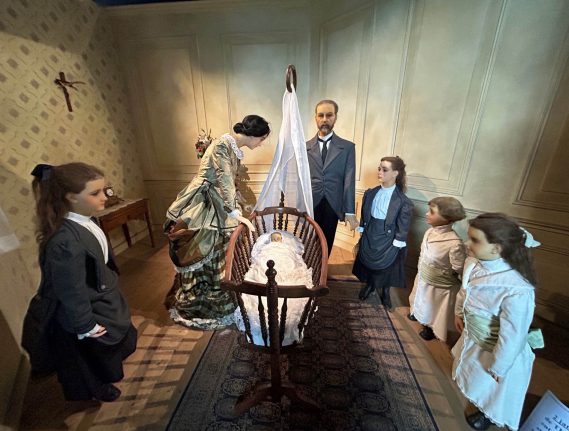
January 2, 1873
Birth at Alençon
Thérèse was born on a Thursday at 11:30 p.m., “under a lucky star”, surrounded by her parents Louis and Zélie, and her sisters Marie, Pauline, Léonie and Céline. She was baptized on January 4 in the Notre-Dame d’Alençon basilica.
“In one thousand eight hundred and seventy-three,
On the second of January, almost at midnight,
The lovely “Little Thérèse”
Came to earth, without noise.
“To sing Love, she was born”,
Said her Angel with a heart of fire,
“Great will be her destiny”
Heaven answered: “Glory to God!”
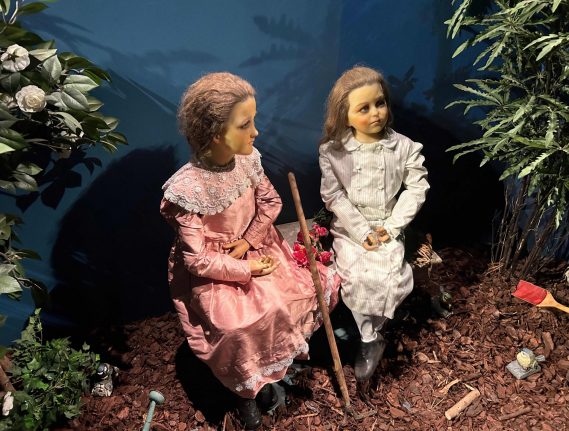
March 4, 1877*
The practice of virtues
Very close, Thérèse and Céline count their practices on a rosary of virtues in the garden on rue Saint-Blaise in Alençon, under the gaze of the neighbor.
*Letter from Zélie to her daughter Pauline
She was only three years old,
And already, according to her confession,
Showing a manly courage,
“Refusing nothing to the good Lord”.
With Céline, her little sister
She talks about her exploits,
And, very quietly, to be discreet,
Counts them on her little fingers.
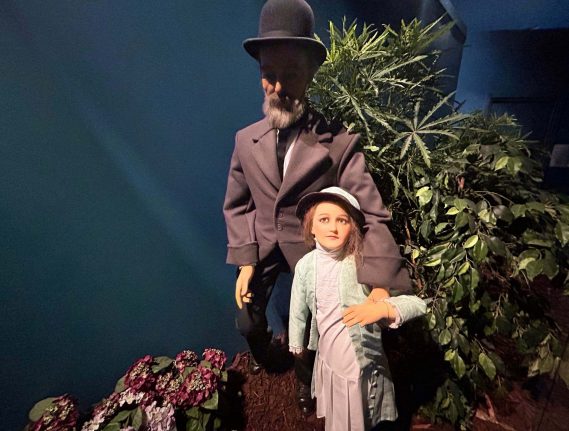
November 15, 1877
Her name in the sky
After Zélie’s death, Louis and his daughters arrived in Lisieux in November 1877 and settled in the Buissonnets house. A few years later, one autumn evening, while she was walking with her father, she saw her name in the sky. It was the stars of the constellation Orion forming a T.
What are you doing there, little girl,
At the hand of your beloved father?
“I look at a T that sparkles,
Of pearls of gold, it is formed;
In order to see it at my ease,
Daddy, lead me, if you want?
Oh happiness! My name of Thérèse,
I find it written in the Heavens!”
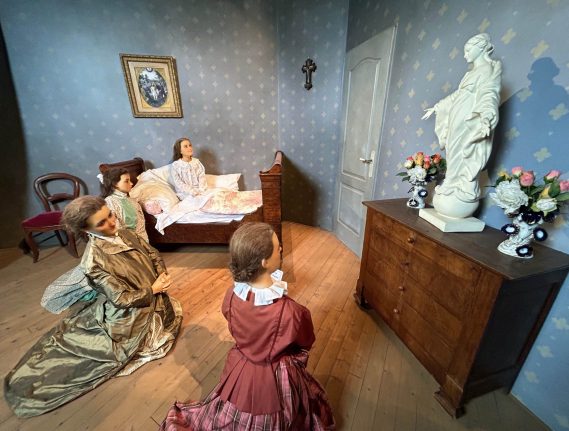
May 13, 1883
The healing of Thérèse by the smile of the Virgin Mary
After her sister Pauline leaves for Carmel, Thérèse suffers from a strange illness. Louis has a novena said to Notre-Dame des Victoires. Marie, Léonie and Céline pray at the foot of her bed. Suddenly, she is healed by the “enchanting smile of the Holy Virgin” in front of the family statue.
Child, you are admired in ecstasy.
But why, at this moment,
So close to the ray that sets you ablaze,
On your eyelid, a diamond?
“It is that the divine light
Soon disappeared from my eyes,
And the smile of my Mother,
I will see it only in Heaven!”
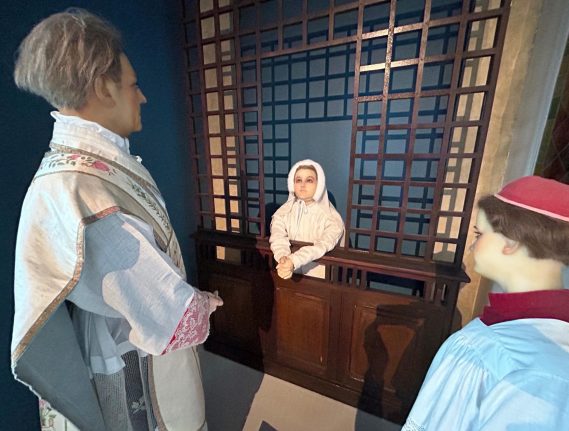
May 8, 1884
First communion at the Benedictine abbey of Lisieux
Thérèse made her first communion at the Notre-Dame du Pré abbey where she was a boarder. She was eleven years old. “Ah! How sweet was the first kiss of Jesus to my soul!” she would write in her manuscripts.
O heavenly day, without clouds,
O First Communion!
That, in sublime language,
Thérèse calls “fusion”.
She seemed as if delighted,
Crying with love and happiness,
Because “infinite joy
In floods penetrated her heart…”
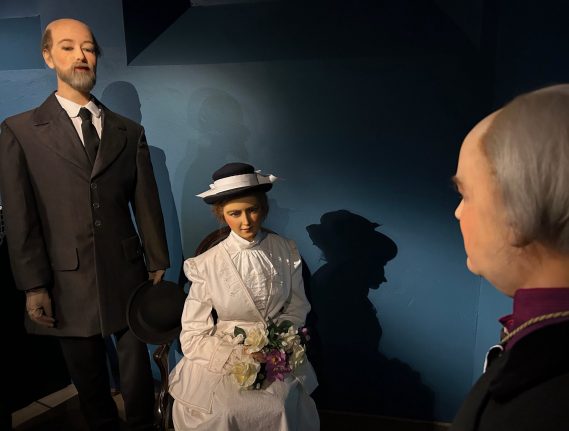
October 31, 1887
Visit to Bishop Hugonin
After asking her father on the day of Pentecost for permission to enter Carmel at the age of 15, Thérèse met Mgr Hugonin, the Bishop of Bayeux, who advised her to wait until she was 21. She had put her hair up in a bun to appear older.
Here is the lovely adolescent
Before Monseigneur de Bayeux;
To age herself – innocent ruse –
She has put up her hair!
“Speak, Thérèse,” said her father,
“Without fear, explain your plan.”
But the Bishop and the Grand Vicar
Listen to her, without deciding anything!
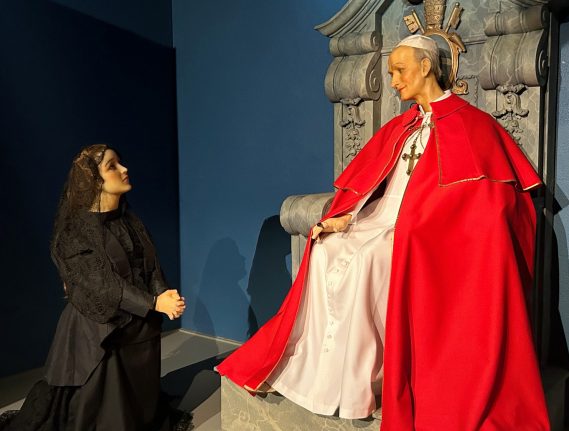
November 20, 1887
Audience of Pope Leo XIII
Taking advantage of a diocesan pilgrimage to Rome, her first major trip, Thérèse asked Pope Leo XIII for a derogation, (“so old that one would think he was dead” she would say with malice) to enter Carmel before the legal age. But the sovereign pontiff replied “Do what the superiors tell you”. Thérèse persevered, he concluded: “You will enter if the Good Lord wills it!”
At the feet of Pope Leo the Thirteen,
We follow her as a last resort.
He blesses you, poor Therese!
But, alas! without fixing your fate.
It was the hour of your weakness,
Another hour, one day, will strike:
In glory and in joy,
The Vatican will see you again…
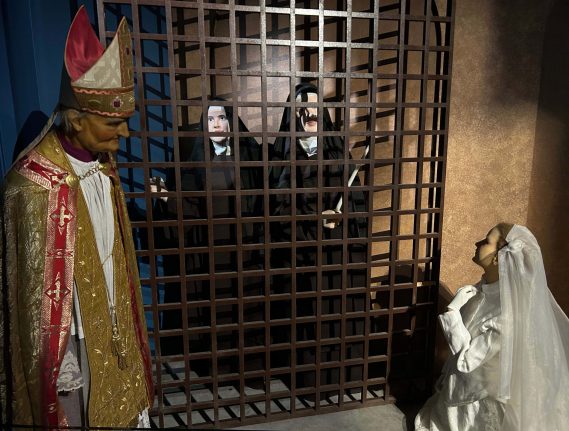
January 10, 1889
Blessing at the Closing Gate
On April 9, 1888, Thérèse entered Carmel as a postulant. Ten months later, under the gaze of Bishop Hugonin, she left the cloister for the last time in bridal attire to receive the blessing of her father, Louis Martin. That day, she received the Carmelite habit.
Thérèse, at the threshold of the Monastery,
On the day of her Taking of the Habit,
Kneels before her Father,
And he, full of faith, blesses her.
“O spectacle worthy of the Angels”,
So simple, but how touching!
Present, celestial phalanxes,
This holocaust to the Almighty.
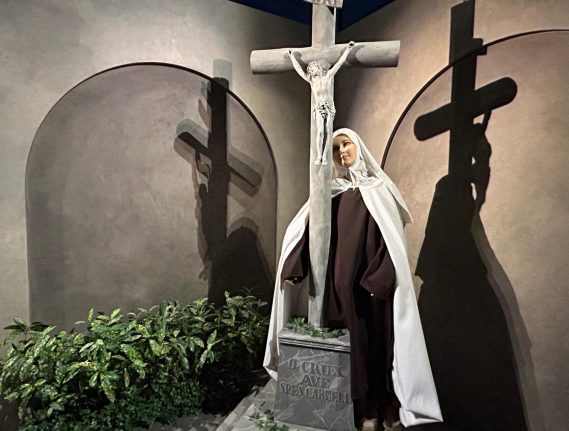
January 17, 1889
Sister Thérèse novice
Having taken the name of Sister Thérèse of the Child Jesus and the Holy Face, the novice experiences the joys and trials of a cloistered life as a Carmelite. She enjoys plucking rose petals at the Calvary in the courtyard.
Jesus draws the novice
More to Calvary than to Tabor.
She welcomes the sacrifice,
As a grace, a true treasure;
But, on the crosses of her lover
A veil by God was thrown.
You, who admire her smiling,
Will know everything in eternity…
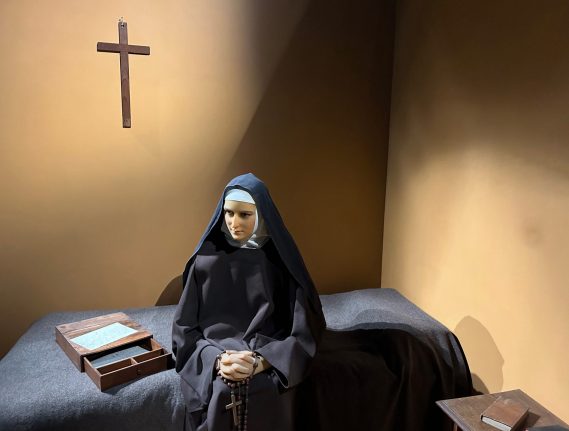
January 20, 1896
Writing manuscripts
At the suggestion of Sister Marie du Sacré-Cœur (Marie Martin) during a recreation in December 1894, Thérèse began writing her manuscripts which would be collected after her death under the title “Story of a soul” published in 1898. She gave Manuscript A to Mother Agnès for her feast day on January 20, 1896 and, seriously ill, left Manuscript C unfinished in June 1897. Each of the manuscripts ends with the word “love.”
In her solitary cell,
Away from human eyes,
In silence and prayer,
She worked with her hands:
Painting and lingerie
Occupied her time in turn;
In the evening, she wrote her Life,
In the breath of the Spirit of love.
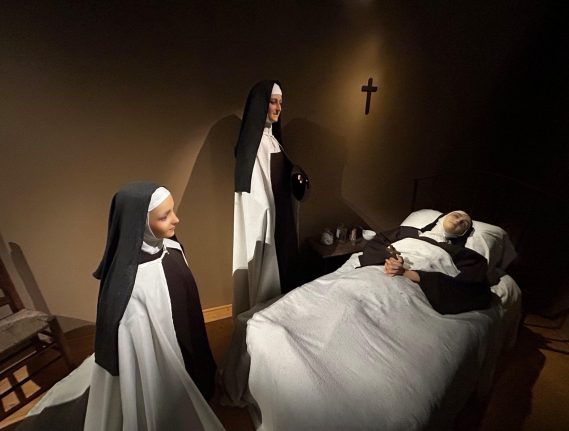
Septembre 30, 1897
Thérèse breathes her last
“Oh! I love him! My God… I love you” were her last words. In the infirmary, surrounded by her sisters, the crucifix in hand, Thérèse breathed her last at 7:20 p.m. In a farewell letter dated June 9, 1897 and addressed to her spiritual brother, Father Maurice Bellière, a missionary, she wrote: “I am not dying, I am entering life and everything I cannot tell you here below, I will make you understand from the heights of Heaven…”
In the midst of a slow agony,
Terrible and so beautiful at the same time,
Suddenly, her forehead radiates,
She seems to say: “I see!”
And, when her eye full of light
Lowers itself in this pale abode,
Thérèse has fled far from the earth,
After having died of love…
Free access to the museum. Thank you for your support.



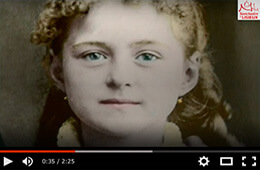 Galerie vidéos
Galerie vidéos 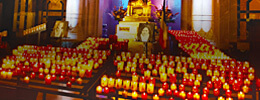 Souvenirs et supports de prière
Souvenirs et supports de prière  Office du Tourisme de Lisieux
Office du Tourisme de Lisieux 